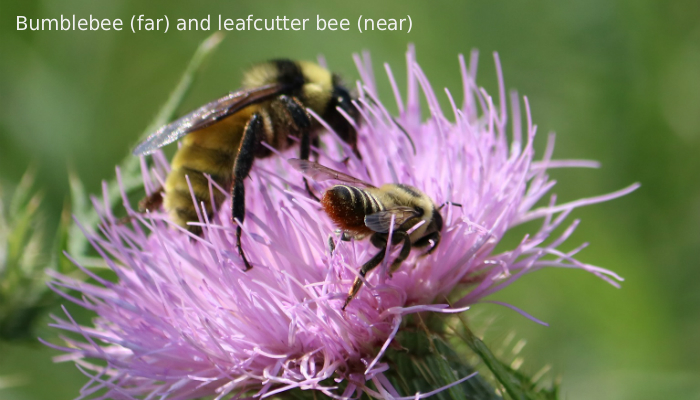Guest Post: Where do Pollinators Go In the Winter?

Now that the weather has turned cooler and we’ve had our first real snow, the question on some people’s minds may be where do pollinators go in the winter. The Pollinator Partnership, with the mission to promote the health of pollinators – critical to food and ecosystems – through conservation, education, and research, has a great blog written by Anthony Colangelo on this specific question. (Photo credit: Melissa Serenda from Sycamore Greenway Friends.)
As the summer season ends and the cooler weather approaches, once magnificent and colorful flowers begin to wither and wilt, while previously buzzing gardens become stems of silence. But where do the pollinators go? Pollinators, such as bees, butterflies, and birds all display a variety of amazing and unique strategies in order to survive the cold weather and overcome the harsh climate of the approaching winter.
As the winter temperatures start to freeze the air, honey bees form special clusters inside their hives to keep warm. Worker honey bees huddle around their queen and vibrate their wings and bodies in a “shivering” behavior in order to generate heat inside the hive. This behavior is amazingly carried out all winter, and uses up a lot of the bees’ energy. In order to fuel this heated huddle, honey bees use their stored honey as a main source of food in order to stay energized and keep the queen and the hive at an optimal temperature throughout the winter.
Bumble bees take a different approach, and only new queens survive the winter, while the rest of the colony dies off. In the fall, male bumble bees mate with future queens from different colonies, and these future queens spend the entire winter underground or in holes in soft wood that are safe and dry. Queen bumble bees are impressively large in size, and must consume as much nectar and pollen as possible in order to build up crucial fat reserves before entering a dormant phase in overwintering sites. In the following spring, queens will emerge and find perfect nesting sites to start brand new colonies of their own.
For native solitary bees, it is common for females to lay eggs in underground nests (mining bees, sweat bees, polyester bees), or in sealed and insulated cavities aboveground (leafcutting bees, mason bees). These eggs then hatch and survive the winter as dormant adults waiting to emerge in the spring, or as developing pupae kept safe and warm inside nests. Once the weather is warm enough, emerged females will find their own independent nesting sites and lay the next generation of eggs!
Probably one of the most famous winter strategies is carried out by monarch butterflies. Monarchs migrate over 3000 miles and 5000 kilometers from Canada and the Northern United States all the way to the oyamel fir forests in Mexico. These forests provide monarchs with the perfect climate and environmental conditions while they wait for the northern winters to pass. For the butterfly species that do not migrate, strategies include surviving the winter in a dormant phase in cocoons, as caterpillars, and some can even survive as mature adults.
Just like monarch butterflies, most hummingbirds in North America also migrate far distances in the winter, such as the Rufous hummingbird which can migrate up to 4000 miles and over 6000 kilometers from Alaska all the way to Mexico. Most ruby-throated hummingbirds also migrate from central and eastern Canada and the United States to Mexico and Central America. During the harsh winters of Canada and the northern United States, the flowers and insects that hummingbirds rely on for food die off, therefore hummingbirds must travel south where the temperature is warm enough to support their need for an abundance of nectar and insects to fuel their extremely fast metabolism.
Whether it be migrating to warmer areas or staying dormant in a safe spot, bees, butterflies, and birds are all pollinators that have adapted incredible strategies to survive the harsh and cold temperatures of winter. These strategies also emphasize the need for more pollinator habitat and pollinator-friendly gardens, as having an abundance of accessible pollen and nectar sources, especially in the fall, is crucial for their survival over the winter season.
Originally published in Pollinator.org


